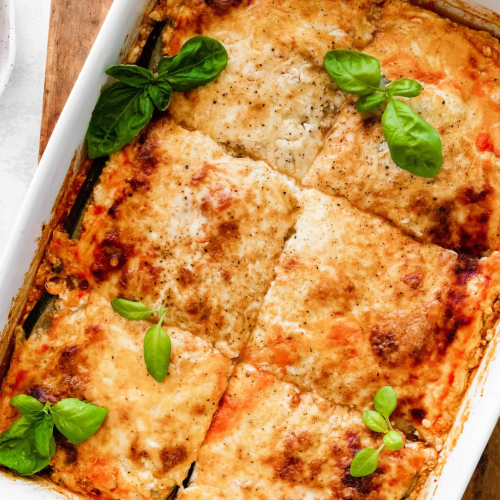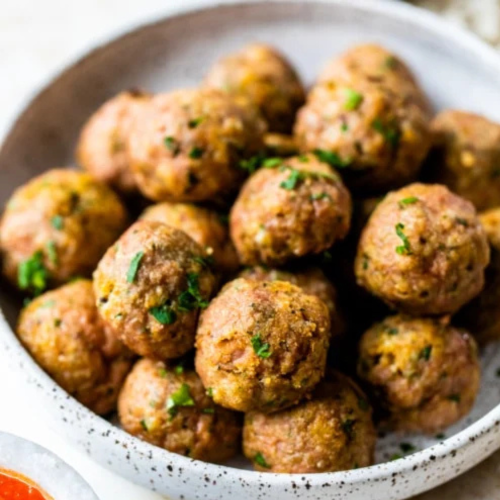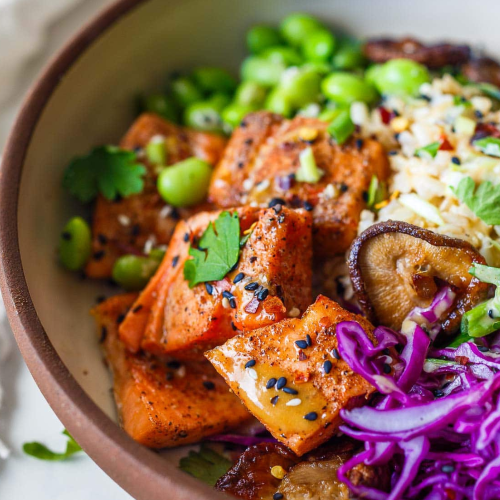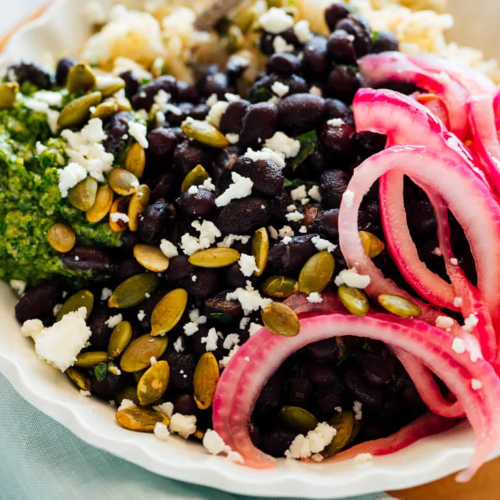Artichokes are a pretty underrated vegetable (they’re technically a thistle), but they’re one of the top foods you can eat to boost your gut microbiome—and more importantly, they’re delicious. Whether you’re tossing them into a salad, using them as a pizza or omelet topper, or blending them into a base for a deliciously creamy dip, cooking with artichokes is a fuss-free way and add major flavor and gut health benefits to your meals. Ahead, we’re sharing a few delicious artichoke recipes to include in your weekly meal prep rotation.
Experts in This Article
registered dietitian nutritionist and author of Anti-Inflammatory Diet Meal Prep
board-certified sports dietitian
Health benefits of artichokes
Artichokes are a boon for gut health filled with digestion-supporting nutrients like prebiotics.
“Artichokes are well-known in the nutrition community for their impressive prebiotic content, which are certain carbohydrates that ‘feed’ probiotics and help to balance your gut microbiome,” says dietitian Kelly Jones, MS, RD, CSSD, LDN. Indeed, while probiotics get a lot of love, prebiotics are a bit lesser known. However, they’re just as important (if not more!), as they feed probiotics in order for them to function and benefit the gut. It’s best to consume a variety of foods high in prebiotics and probiotics to optimize digestion and overall health.
“A half cup of artichokes also contains 240 milligrams of potassium, which is an essential mineral and electrolyte that helps manage fluid balance, muscle contractions, and blood pressure. Lastly, artichokes are a good source of magnesium.” —Kelly Jones, MS, RD, CSSD, LDN
Research also shows that artichokes help promote the growth of beneficial bacteria in the gut. “Specifically, one study recently showed an increase in short-chain fatty acid production in the gut following artichoke consumption,” Jones says. “These fatty acids help support your gut by providing energy to your colon cells to help them function properly. They also assist in the metabolization of important nutrients like carbs and other fats,” she says.
Artichokes are also rich in both soluble and insoluble fiber, which Jones says can help support regular bowel movements and reduce both constipation and digestive discomfort. “Eating plenty of fiber has been linked to lower blood cholesterol levels and better heart health,” she says. “A half cup of artichokes also contains 240 milligrams of potassium, which is an essential mineral and electrolyte that helps manage fluid balance, muscle contractions, and blood pressure. Lastly, artichokes are a good source of magnesium,” Jones concludes.
How to cook an artichoke, step-by-step
One look at an artichoke, and you may be thinking to yourself, how in the world do I cook this thing? Well, same. The good news? Its appearance is far more intimidating than cooking it really is. In fact, all it takes are three simple steps to steam artichokes (arguably the best way to cook them) from start to finish.
1. Prep the artichoke
You’ll want to tackle the stem first. Start by cutting away any of the tough petals on the stem with a small paring knife. Once the stem is trimmed, cut the bottom end of the artichoke to remove the dried-out section only.
Next, apply Love & Lemon’s genius pro tip for cooking artichokes: Score the bottom of the stem lightly with a cross (helps expedite the cooking process) and coat it with a splash of lemon juice (this helps prevent browning). Then, using a Y-peeler, remove the outermost layer of the artichoke stem until it’s nice and smooth.
Now, you can tackle the upper portion. For best results when steaming an artichoke, you’ll want to cut the top section of the artichoke off (about two inches from the top) across the equator. Feel free to discard or throw in your compost bin the top portion, as it’s likely too tough to eat. Again, to prevent browning and oxidation, rub lemon juice on the exposed surface.
Score the bottom of the stem lightly with a cross (helps expedite the cooking process) and coat it with a splash of lemon juice (this helps prevent browning). Then, using a Y-peeler, remove the outermost layer of the artichoke stem until it’s nice and smooth.
2. Steam the artichoke
Once the artichoke is fully prepped and ready to go, fill a large pot with about an inch of water. (Enough where it’s not touching a steamer basket when placed on top.) Bring the water to a boil, and once boiling, lower it to a simmer.
Next, arrange the artichokes in the steamer basket. Cover and let them steam for roughly 30 to 45 minutes, depending on the size. You’ll know when it’s ready when the stem is tender and the petals peel off easily.
3. Remove the choke
After the steamed artichokes are cool enough to handle, cut them in half lengthwise. Then, gently carve out the artichoke’s choke using a small spoon, aka the fuzzy-haired center, which is inedible. From there, the artichoke is ready to serve. However, you can take it one step further by drizzling them with some cooking oil, before grilling for added umami.
Ready to get cooking with this delicious thistle? Here are six delicious artichoke recipes that are super easy to make.
6 artichoke recipes that are packed with gut-boosting benefits

1. Healthy Spinach Artichoke Dip
This hearty artichoke dip by Real Simple Good is packed with a considerable amount of protein and fiber. “Instead of an emphasis on the ‘creamy,’ the focus is on veggies, and it uses artichoke hearts and spinach,” says registered dietitian nutritionist Ginger Hultin, MS, RDN, CSO. For context, each serving of this tasty side dish offers about two grams of protein and two grams of fiber.
Five simple ingredients is all you need to make it: canned artichoke hearts, mayo, nutritional yeast, spinach, and garlic. That’s it. Plus, if you want to make it vegan, simply sub the mayo for vegan mayo, and done. Meanwhile, if you eat dairy, feel free to throw in a serving of cheese, but this blogger uses nutritional yeast, a vegan cheese alternative that happens to be super high in protein and vitamin B.
Get the recipe: Healthy Spinach Artichoke Dip

2. Roasted Artichoke Salad
This simple roasted artichoke salad by Love & Lemons is the definition of beauty and grace (for our digestive system) ideal for noshing on just about any day (or time) of the week. “Because this hearty salad contains lots of veggies plus whole grains and protein-packed chickpeas, it’s perfectly balanced for work or school lunches all week,” Hultin says. In addition to the roasted artichokes, you’ll find a handful of mint gives it an aromatic feel and complements this salad’s refreshing nature. Refreshing, delicious, and healthy lunch recipe is an understatement. Swoon.
Get the recipe: Roasted Artichoke Salad

3. Spinach Artichoke Egg Casserole
Easy breakfast for a crowd? Say no more. This super simple spinach egg casserole by A Spicy Perspective is rich in veggies like artichokes, along with a variety of herbs and spices. The best part? It takes a mere ten minutes to prep. Plus, all of the above ingredients—in addition to the onion, spinach, and crushed red pepper—bring flavor and anti-inflammatory benefits.
What about the protein, you may ask? Well, this recipe has plenty of the nutrient (a whopping 16 grams per serving, to be exact). “Because it’s cheese and egg-based, this recipe also includes a lot of protein and bone-boosting calcium,” Hultin says. And since you can make a big batch, save the rest for leftovers.
Get the recipe: Spinach Artichoke Egg Casserole

4. Chicken, Lemon, and Artichoke Soup
Brighten up your chicken soup with this recipe by Love Chef Laura that’s packed with comforting veggies such as onion, carrots, celery, spinach, and chopped artichoke hearts—all of which are rich in anti-inflammatory benefits. “You’ll get a boost of fiber, vitamins, minerals, and antioxidants from this spin on a classic chicken soup recipe,” Hultin says. And it’s so comforting (plus it takes just 30 minutes to cook). Pair this recipe with a cup of artichoke tea if you’re feeling under the weather, and you’ve got yourself the perfect immune-boosting meal.
Get the recipe: Chicken, Lemon, and Artichoke Soup

5. Pesto Orzo With Lemon, Artichokes, and Shrimp
“If you need a quick weeknight dinner, make this dish by Walder Wellness in advance to use for easy meal prep or to enjoy as a quick after-work option,” Hultin says. You need only six ingredients, which makes it easy to whip up on the spot (and budget for when shopping at the store). “This dish is rich in anti-inflammatory properties from the pesto sauce, prebiotics and fiber from artichokes, and protein from the shrimp,” she adds.
Get the recipe: Pesto Orzo With Lemon, Artichokes & Shrimp

6. Spinach Artichoke Chicken Burgers
There’s no doubt we’ll be grilling these gut-friendly chicken burgers by Paleo Running Mamaall summer long. Pro tip: “If you want a little extra flavor and nutrition in this dish, you can top the burgers with sliced artichoke hearts,” Hultin says.
Get the recipe: Spinach Artichoke Chicken Burgers
FAQs on artichoke recipes and prep
Why do you soak artichokes in water?
Because uncooked artichokes tend to oxidize quickly once they’re cut into, you may want to submerge them in cold water with lemon juice to slow down any browning. This is especially helpful when moving between tasks. What’s more, submerging the ingredient in water can also help dislodge any grit or grime stuck between the tough petals.
What’s the best way to eat artichokes?
Once your artichokes are steamed and ready to eat, you’ll want to remove the leaves and dip them into the sauce of your choice (melted garlic butter is always a great option). Keep in mind that you should use your teeth to gently scrape off the “meat” from each petal, before discarding the tough shell. That said, the artichoke heart and peeled stems are safe to eat completely, as they’re tender enough to chew and digest.
Of course, if you want to spare yourself the trouble, you can always opt for ready-to-eat canned artichoke hearts.
Sign Up for Our Daily Newsletter
Get all the latest in wellness, trends, food, fitness, beauty, and more delivered right to your inbox.
Got it, you've been added to our email list.



































